Acoustic Properties of 316L Stainless Steel Hollow Sphere Composites Fabricated by Pressure Casting
Abstract
:1. Introduction
2. Materials and Methods
2.1. Materials
2.2. Preparation of MHSCs
2.2.1. Preparation of MHSC-3.28 and MHSC-5.76
2.2.2. Preparation of MHSC-LS
2.3. Characterization
2.3.1. Physical Properties of MHSC-3.28 and MHSC-5.76
2.3.2. Physical Properties of MHSC-LS
2.3.3. Microstructure Analysis of MHS and MHSCs
2.3.4. Acoustic Properties of MHSCs
3. Results and Analysis
3.1. Physical Properties of the MHSCs
3.2. Microstructural Analysis
3.2.1. Microstructural Analysis of the MHSs
3.2.2. Microstructural Analysis of the MHSCs
3.3. Acoustic Performance of the MHSCs
4. Discussion
4.1. The Propagation Mechanism of Sound Waves in the MHSC
4.2. The Arrangement of MHSs on the Acoustic Properties of MHSC
4.3. The Diameter of MHS on the Acoustic Properties of MHSC
5. Conclusions
Author Contributions
Funding
Conflicts of Interest
References
- Badini, C.; Busse, M.; Kayvantash, K.; Lehmhus, D. Advanced materials in transportation. Adv. Eng. Mater. 2010, 12, 557–652. [Google Scholar]
- Rugele, K.; Lehmhus, D.; Hussainova, I.; Peculevica, J.; Lisnanskis, M.; Shishkin, A. Effect of fly-ash cenospheres on properties of clay-ceramic syntactic Foams. Materials 2017, 10, 828. [Google Scholar] [CrossRef] [Green Version]
- Shishkin, A.; Mironovs, V.; Zemchenkov, V.; Antonov, M.; Hussainova, I. Hybrid syntactic foams of metal-fly ash cenosphere-clay. Key Eng. Mater. 2016, 674, 35–40. [Google Scholar] [CrossRef]
- Shishkin, A.; Hussainova, I.; Kozlov, V.; Lisnanskis, M.; Leroy, P.; Lehmhus, D. Metal-coated cenospheres obtained via magnetron sputter coating: A new precursor for syntactic foams. JOM 2018, 70, 1319–1325. [Google Scholar] [CrossRef]
- Shishkin, A.; Drozdova, M.; Kozlov, V.; Hussainova, I.; Lehmhus, D. Vibration-assisted sputter coating of cenospheres: A new approach for realizing cu-based metal matrix myntactic foams. Metals 2017, 7, 16. [Google Scholar] [CrossRef] [Green Version]
- Gupta, N.; Nagorny, R. Tensile properties of glass microballoon-epoxy resin syntactic foams. J. Appl. Polym. Sci. 2006, 102, 1254–1261. [Google Scholar] [CrossRef]
- Huang, R.; Li, P. Elastic behaviour and failure mechanism in epoxy syntactic foams: The effect of glass microballoon volume fractions. Compos. B Eng. 2015, 78, 401–408. [Google Scholar] [CrossRef]
- Peroni, L.; Scapin, M.; Lehmhus, D.; Baumeister, J.; Busse, M.; Avalle, M. High strain rate tensile and compressive testing and performance of mesoporous invar (FeNi36) matrix syntactic foams produced by feedstock extrusion. Adv. Eng. Mater. 2016, 19, 1600474. [Google Scholar] [CrossRef]
- Weise, J.; Lehmhus, D.; Baumeister, J.; Kun, R.; Bayoumi, M.; Busse, M. Production and properties of 316L stainless steel cellular materials and syntactic foams. Steel Res. Int. 2014, 85, 486–497. [Google Scholar] [CrossRef]
- Gupta, M.; Wong, W.L.E. High performance magnesium based composites containing nano-length scale/amorphous/hollow reinforcements. Mater. Sci. Forum. 2016, 879, 642–647. [Google Scholar] [CrossRef]
- Caty, O.; Maire, E.; Douillar, T.; Bertino, P.; Dejaeger, R.; Bouchet, R. Experimental determination of the macroscopic fatigue properties of metal hollow sphere structures. Mater. Lett. 2009, 63, 1131–1134. [Google Scholar] [CrossRef]
- Arenas, J.P.; Crocker, M.J. Recent trends in porous sound absorbing materials. Sound Vib. 2010, 44, 12–17. [Google Scholar]
- Fallet, A.; Lhuissier, P.; Salvo, L.; Martin, C.L.; Wiegmann, A.; Kabel, M. Multifunctional optimization of random hollow sphere stackings. Scr. Mater. 2013, 68, 35–38. [Google Scholar] [CrossRef]
- Rabiei, A.; Vendra, L.; Reese, N.; Young, N.; Neville, B.P. Processing and characterization of a new composite metal foam. Mater. Trans. 2006, 47, 2148–2153. [Google Scholar] [CrossRef] [Green Version]
- Neville, B.P.; Rabiei, A. Composite metal foams processed through powder metallurgy. Mater. Des. 2008, 29, 388–396. [Google Scholar] [CrossRef]
- Goehler, H.; Jehring, U.; Meinert, J.; Hauser, R.; Quadbeck, P.; Kuemmel, K. Functionalized metallic hollow sphere Structures. Adv. Eng. Mater. 2014, 16, 335–339. [Google Scholar] [CrossRef]
- Sanders, W.S.; Gibson, L.J. Mechanics of hollow sphere foams. Mater. Sci. Eng. A 2003, 347, 70–85. [Google Scholar] [CrossRef]
- Friedl, O.; Motz, C.; Peterlik, H.; Puchegger, S.; Reger, N.; Pippan, R. Experimental investigation of mechanical properties of metallic hollow sphere structures. Metall. Mater. Trans. B 2008, 39, 135–146. [Google Scholar] [CrossRef]
- Vesenjak, M.; Ren, Z.; Fiedler, T.; Öchsner, A. Impact behavior of composite hollow sphere structures. J. Compos. Mater. 2009, 43, 2491–2505. [Google Scholar] [CrossRef]
- Brown, J.A.; Vendra, L.J.; Rabiei, A. Bending Properties of Al-steel and steel-steel composite metal foams. Metall. Mater. Trans. A 2010, 41, 2784–2793. [Google Scholar] [CrossRef]
- Vendra, L.J.; Rabiei, A. Evaluation of modulus of elasticity of composite metal foams by experimental and numerical techniques. Mater. Sci. Eng. A 2010, 527, 1784–1790. [Google Scholar] [CrossRef]
- Vendra, L.J.; Brown, J.A.; Rabiei, A. Effect of processing parameters on the microstructure and mechanical properties of Al-steel composite foam. J. Mater. Sci. 2011, 46, 4574–4581. [Google Scholar] [CrossRef]
- Rabiei, A.; Garcia-Avila, M. Effect of various parameters on properties of composite steel foams under variety of loading rates. Mater. Sci. Eng. A 2013, 564, 539–547. [Google Scholar] [CrossRef]
- Alvandi-Tabrizi, Y.; Whisler, D.A.; Kim, H.; Rabiei, A. High strain rate behavior of composite metal foams. Mater. Sci. Eng. A 2015, 631, 248–257. [Google Scholar] [CrossRef]
- Chen, S.; Marx, J.; Rabiei, A. Experimental and computational studies on the thermal behavior and fire retardant properties of composite metal foams. Int. J. Therm. Sci. 2016, 106, 70–79. [Google Scholar] [CrossRef] [Green Version]
- Chen, S.; Bourham, M.; Rabiei, A. Applications of open-cell and closed-cell metal foams for radiation shielding. Procedia Mater. Sci. 2014, 4, 293–298. [Google Scholar] [CrossRef] [Green Version]
- Chen, S.; Bourham, M.; Rabiei, A. Attenuation efficiency of X-ray and comparison to gamma ray and neutrons in composite metal foams. Radiat. Phys. Chem. 2015, 117, 12–22. [Google Scholar] [CrossRef] [Green Version]
- Chen, S.; Bourham, M.; Rabiei, A. Neutrons attenuation on composite metal foams and hybrid open-cell Al foam. Radiat. Phys. Chem. 2015, 109, 27–39. [Google Scholar] [CrossRef] [Green Version]
- Marx, J.; Portanova, M.; Rabiei, A. A study on blast and fragment resistance of composite metal foams through experimental and modeling approaches. Compos. Struct. 2018, 194, 652–661. [Google Scholar] [CrossRef]
- Marx, J.; Portanova, M.; Rabiei, A. Ballistic performance of composite metal foams. Compos. Struct. 2015, 125, 202–211. [Google Scholar]
- Majlinger, K.; Orbulov, I.N. Characteristic compressive properties of hybrid metal matrix syntactic foams. Mater. Sci. Eng. A 2014, 606, 248–256. [Google Scholar] [CrossRef]
- Orbulov, I.N.; Májlinger, K. Characterisation of hybrid metal matrix syntactic foams. Mater. Sci. Forum. 2015, 812, 219–222. [Google Scholar] [CrossRef] [Green Version]
- Szlancsik, A.; Katona, B.; Bobor, K.; Majlinger, K.; Orbulov, I.N. Compressive behavior of aluminium matrix syntactic foams reinforced by iron hollow spheres. Mater. Des. 2015, 83, 230–237. [Google Scholar] [CrossRef] [Green Version]
- Cochran, J.K. Ceramic Hollow Spheres and Their Applications. Curr. Opin. Solid State Mater. Sci. 1998, 3, 474–479. [Google Scholar] [CrossRef]
- Wang, X.; Lu, T.J. Optimized acoustic properties of cellular solids. Acoust. Soc. Am. 1999, 106, 756–765. [Google Scholar] [CrossRef]
- Wu, G.; Li, R.; Yuan, Y.; Jiang, L.; Sun, D. Sound absorption properties of ceramic hollow sphere structures with micro-sized open cell. Mater. Lett. 2014, 134, 268–271. [Google Scholar] [CrossRef]
- Yu, T.; Jiang, F.; Wang, C.; Cao, M.; Wang, Z.; Chang, Y.; Guo, C. Investigation on fabrication and microstructure of Ti-6Al-4V alloy hollow spheres by powder metallurgy. Met. Mater. Int. 2019. [Google Scholar] [CrossRef]
- Rayleigh, J.W.S. The Theory of Sound; Dover Publications: New York, NY, USA, 1896. [Google Scholar]
- Zwikker, C.; Kosten, C.W. Sound Absorbing Materials; Elsevier: Amsterdam, The Netherlands, 1949. [Google Scholar]
- Komatsu, T. Improvement of the Delany–Bazley and Miki models for fibrous sound-absorbing materials. Acoust. Sci Technol. 2008, 29, 121–129. [Google Scholar] [CrossRef] [Green Version]
- Allard, J.F.; Daigle, G. Propagation of sound in porous media: Modeling sound absorbing materials. J. Acoust. Soc. Am. 1994, 95, 2785. [Google Scholar] [CrossRef] [Green Version]
- Li, Y.; Wang, X.; Wang, X.; Ren, Y.; Han, F.; Wen, C. Sound absorption characteristics of aluminum foam with spherical cells. J. Appl. Phys. 2011, 110, 113525.1–113525.7. [Google Scholar] [CrossRef]
- Bao, H.Q.; Zhang, N.; Hou, X.G. Analysis of the influence of static flow resistance on the sound absorption properties of aluminum foam. Adv. Mater. 2012, 535–537, 1459–1462. [Google Scholar] [CrossRef]
- Sun, J.X.; Duan, C.Y.; Liu, P.S. Sound absorption characterization of aluminum foam made by press infiltration casting multidiscip. Model. Mater. Struct. 2016, 12, 737–747. [Google Scholar] [CrossRef]
- Han, F.; Seiffert, G.; Zhao, Y.; Gibbs, B. Acoustic absorption behaviour of an open-celled aluminium foam. J. Appl. Phys. 2003, 36, 294–302. [Google Scholar] [CrossRef] [Green Version]
- Bao, H.Q.; Zhang, N.; Hou, X.G. Primary investigation on sound absorption performance of highly porous titanium foams. Mater. Des. 2015, 85, 275–281. [Google Scholar]
- Tatarinov, A.; Shishkin, A.; Mironovs, V. Correlation between ultrasound velocity, density and strength in metal-ceramic composites with added hollow spheres. IOP Conf. Ser. Mater. Sci. Eng. 2019, 660, 012040. [Google Scholar] [CrossRef]




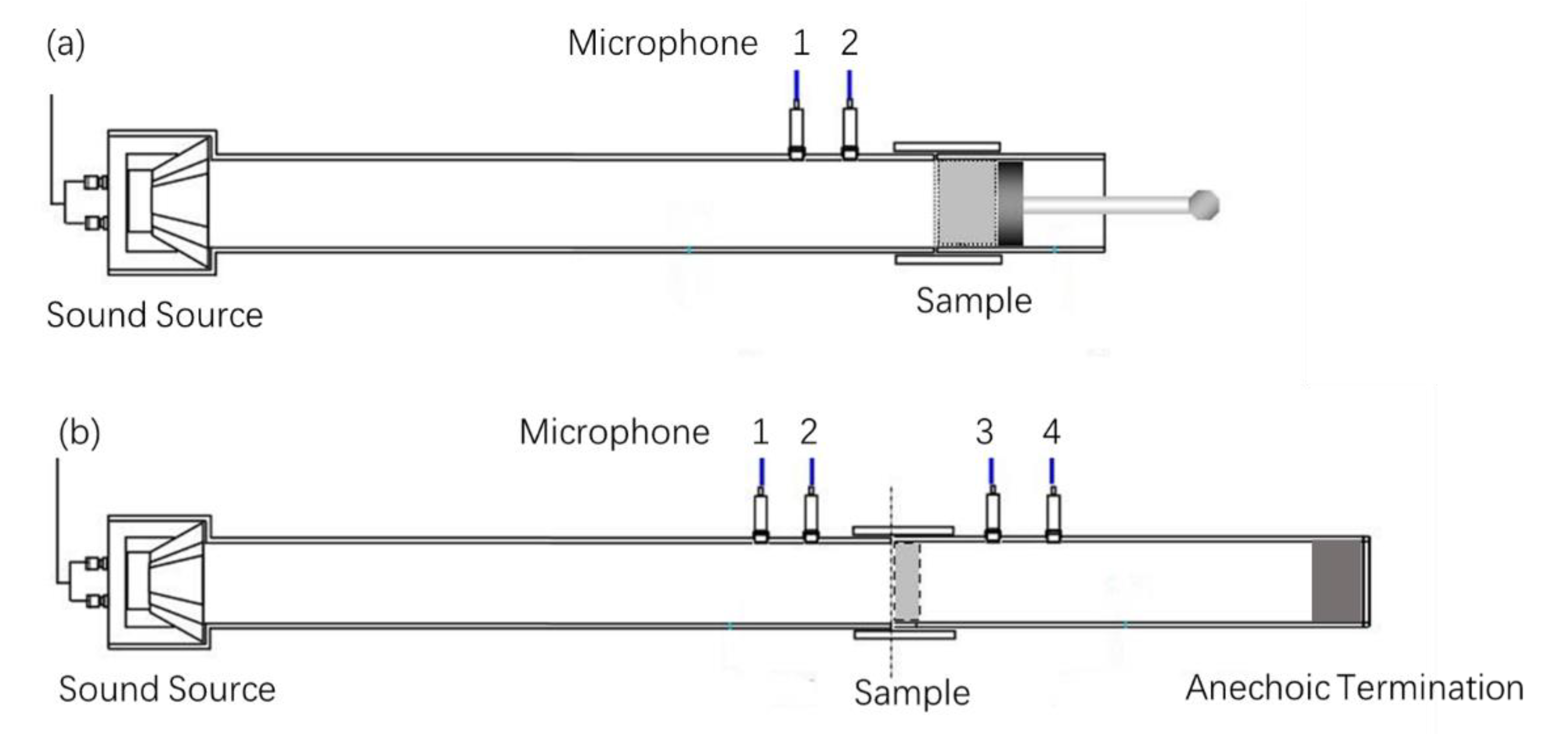
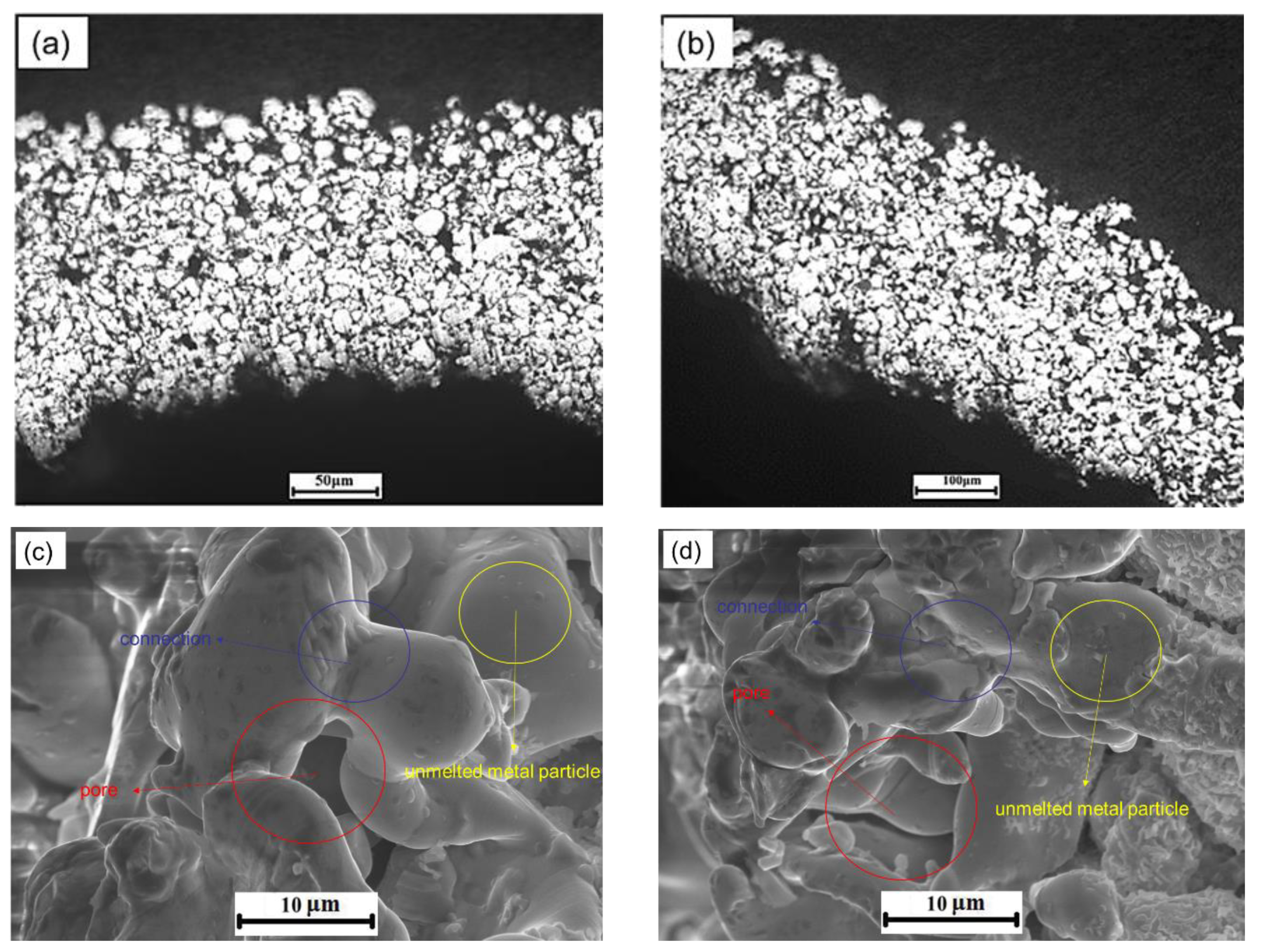
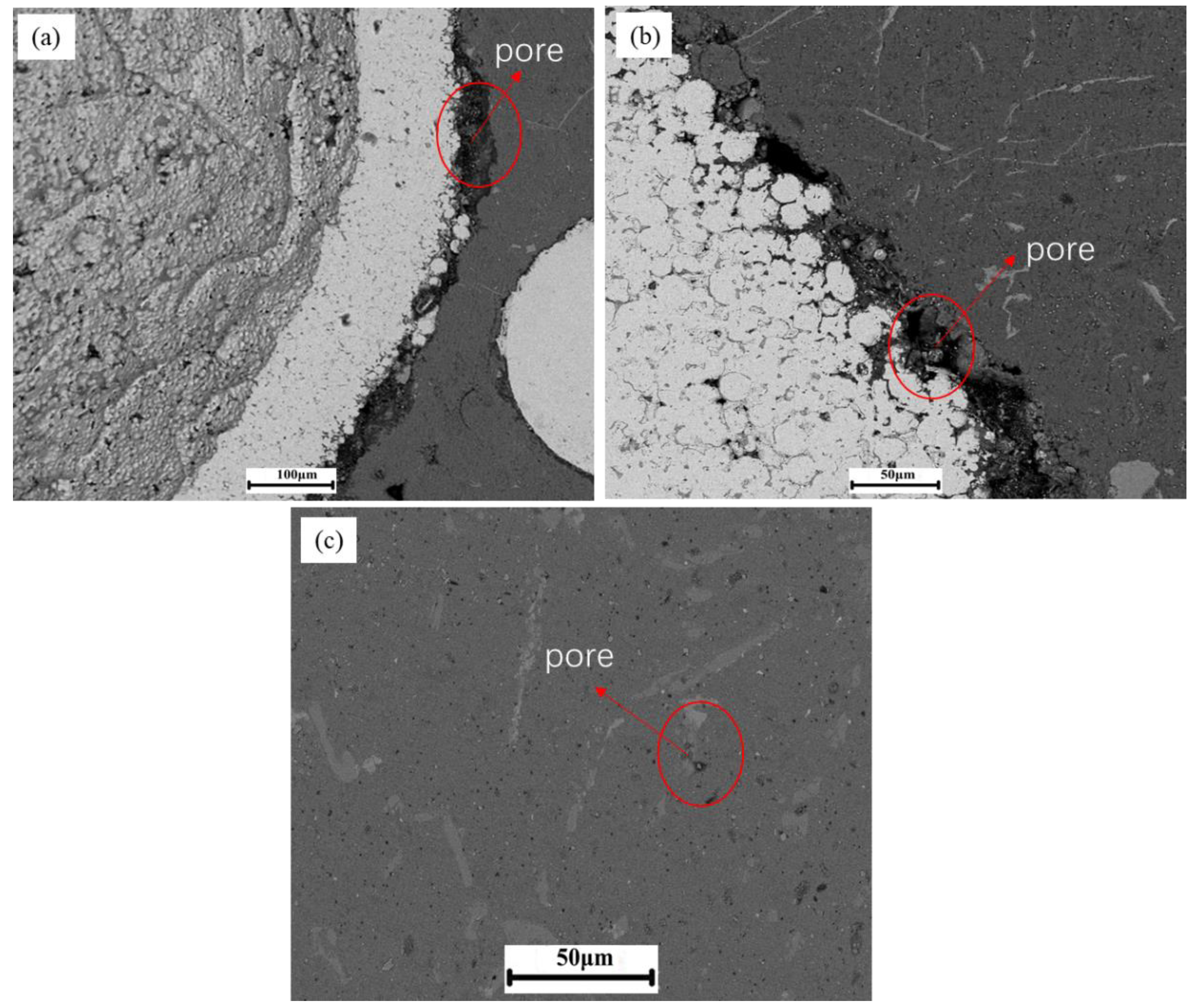


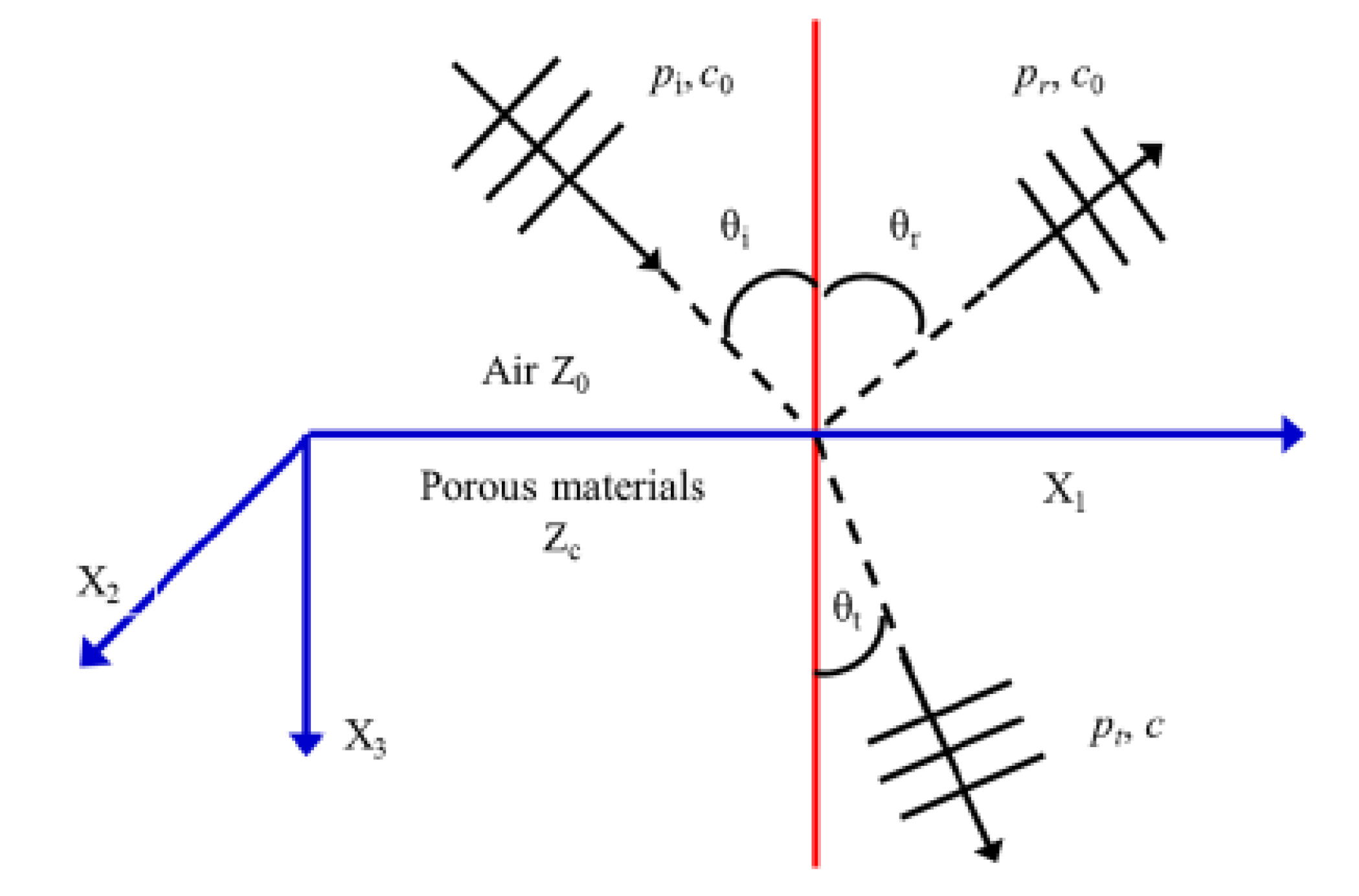


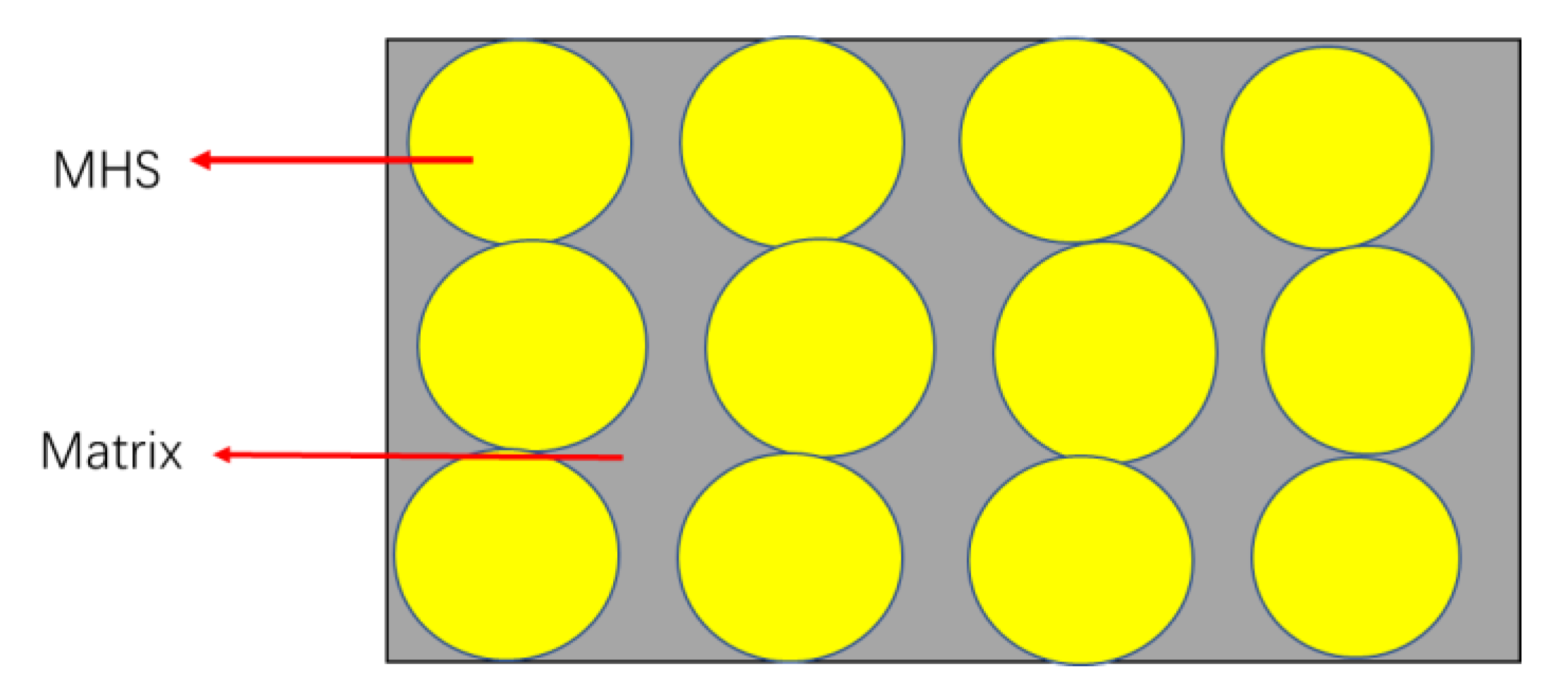
| Element | Fe | Si | Cu | Mg | Mn | Zn | Ti | Pb | Ni | Sn | Al |
|---|---|---|---|---|---|---|---|---|---|---|---|
| wt.% | 0.14 | 7.18 | 0.01 | 0.37 | 0.01 | 0.01 | 0.16 | - | - | - | balance |
| Sphere Size (mm) | Wall Thickness (μm) | Weight (g) | Wall Porosity (%) | Chemical Composition (%) | ||||||
|---|---|---|---|---|---|---|---|---|---|---|
| C | Mn | Si | Cr | Ni | Mo | Fe | ||||
| 3.28 ± 0.002 | 157 ± 2 | 0.02 ± 0.005 | 47.87 ± 0.003 | 0.01 | 1 | 0.2 | 17 | 12 | 2 | balance |
| 5.76 ± 0.002 | 276 ± 2 | 0.11 ± 0.005 | 47.87 ± 0.003 | |||||||
| Sample | Apparent Density (g/cm3) | ||||
|---|---|---|---|---|---|
| MHSC-3.28-1 | 1.74 | 45.30 | 48.50 | - | 6.20 |
| MHSC-3.28-2 | 1.77 | 46.42 | 48.50 | - | 5.08 |
| MHSC-3.28-3 | 1.75 | 45.67 | 48.50 | - | 5.83 |
| MHSC-5.76-1 | 1.74 | 45.35 | 48.50 | - | 6.15 |
| MHSC-5.76-2 | 1.75 | 45.71 | 48.50 | - | 5.79 |
| MHSC-5.76-3 | 1.76 | 45.94 | 48.50 | - | 5.56 |
| MHSC-LS -1 | 1.95 | 44.66 | 48.50 | 2.97 | 3.87 |
| MHSC-LS -2 | 1.93 | 43.66 | 48.50 | 2.97 | 4.87 |
| MHSC-LS -3 | 1.97 | 45.15 | 48.50 | 2.97 | 3.38 |
© 2020 by the authors. Licensee MDPI, Basel, Switzerland. This article is an open access article distributed under the terms and conditions of the Creative Commons Attribution (CC BY) license (http://creativecommons.org/licenses/by/4.0/).
Share and Cite
Wang, C.; Jiang, F.; Shao, S.; Yu, T.; Guo, C. Acoustic Properties of 316L Stainless Steel Hollow Sphere Composites Fabricated by Pressure Casting. Metals 2020, 10, 1047. https://doi.org/10.3390/met10081047
Wang C, Jiang F, Shao S, Yu T, Guo C. Acoustic Properties of 316L Stainless Steel Hollow Sphere Composites Fabricated by Pressure Casting. Metals. 2020; 10(8):1047. https://doi.org/10.3390/met10081047
Chicago/Turabian StyleWang, Chunhe, Fengchun Jiang, Shuaiqi Shao, Tianmiao Yu, and Chunhuan Guo. 2020. "Acoustic Properties of 316L Stainless Steel Hollow Sphere Composites Fabricated by Pressure Casting" Metals 10, no. 8: 1047. https://doi.org/10.3390/met10081047




